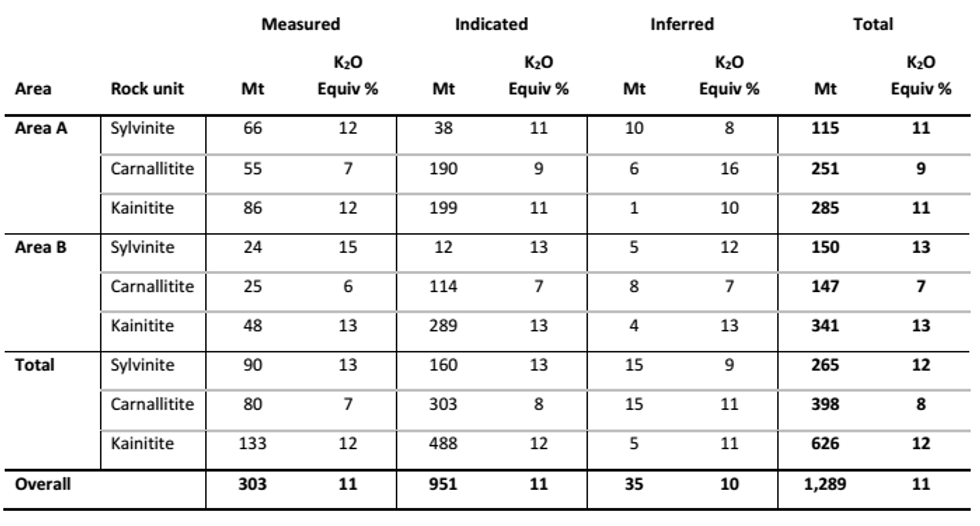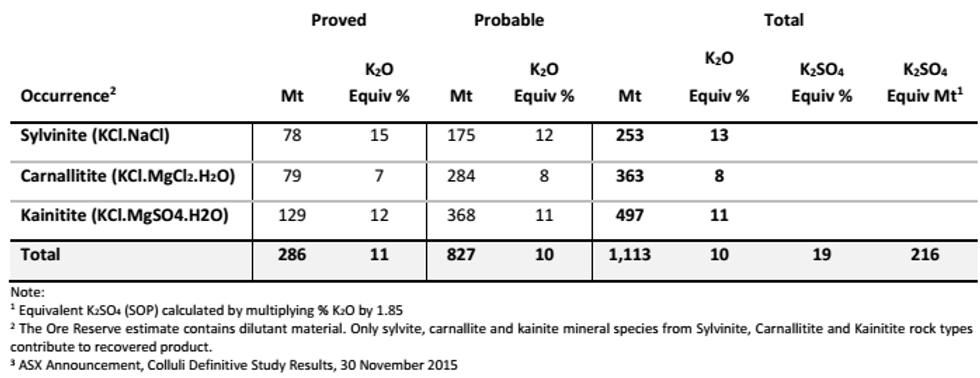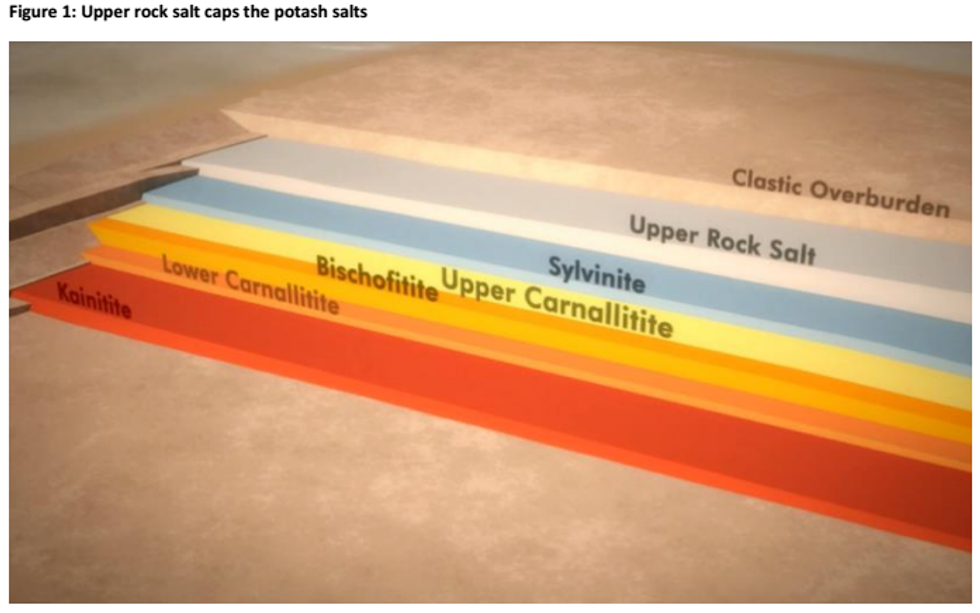FEED Optimisation Increases Planned Sulphate of Potash Production Capacity at Colluli

Danakali Limited (ASX:DNK) and the Eritrean National Mining Corporation are pleased to advise that the optimisation phase of the front-end engineering design process has been completed.
Key Points
- FEED optimisation complete
- Optimised processing plant SOP output increased by an expected 47kt per annum
- Further development capital reduction opportunities identified
- Further process water consumption reduction expected
- FEED equipment lists and procurement strategy well advanced and integrated with funding work stream
- Pre-construction geotechnical work well progressed
- FEED process progressing to schedule
- Detailed mine schedules to be refined and aligned with modified SOP output rate
Danakali Limited (ASX:DNK) and the Eritrean National Mining Corporation (“ENAMCO”) are pleased to advise that the optimisation phase of the front-end engineering design (“FEED”) process has been completed. In addition to identifying a number of significant development capital reduction opportunities, systematic debottlenecking of the definitivefeasibility study (“DFS”) processing plant configuration has liberated an additional 47kt per annum of expected sulphate of potash (“SOP”) output capacity. The additional expected capacity has been confirmed by the FEED lead engineer and is the result of a comprehensive process engineering and infrastructure review. The additional capacity increases the expected Module I annual SOP output to 472kt per annum from the DFS planned output of 425kt per annum1,2 .
The DFS incorporated a long-term price estimate of US$572 per tonne SOP, with estimated mine gate and total cash costs for Module I (@425kt per annum) of US$167 per tonne SOP and US$255 per tonne SOP respectively, and mine gate and total cash costs for Module I and Module II combined1 (@850kt per annum) of US$141 per tonne SOP and US$227 per tonne SOP respectively. The same assumptions have been applied to the revised production forecast pending a finalised set of FEED economics
In addition to the increase in expected product output, the value engineering and optimisation work has identified further opportunities to reduce development capital and water consumption, which have been incorporated into the optimised configuration and are being costed as part of the FEED. The FEED process is well advanced and progressing to schedule. Key areas of potential capital reduction include further optimisation of non-processing infrastructure, reducing the overall site footprint size and reducing recovery pond size following reconfiguration of the brine circuits and increasing brine density to the recovery ponds. This is expected to reduce process water requirements per tonne of SOP product. Refined water usage modelling is underway following the brine circuit optimisation.
Optimisation of the construction schedule has also commenced. Managing Director, Paul Donaldson said “This excellent result is a direct consequence of clever process plant design during the DFS. The liberation of over 10% production capacity with no expected increase in capital cost is clearly value accretive relative to the DFS and further improves on the industry leading capital intensity and outstanding economics demonstrated by the project. Refined and optimised pit schedules reflecting the optimised production rate will now be developed to support the mining contract tendering process. It is also pleasing that the optimisation work has been achieved with no impact on the expected delivery of the FEED.”
1. ASX Announcement, Colluli Definitive Study Results, 30 November 2015
2. No proportion of the production target is based on inferred resources
Mineral Resource and Ore Reserves
The Colluli resource comprises three potassium bearing salts in solid form: sylvinite, carnallitite and kainitite. These salts are suitable for high yield, low energy production of SOP, which is a high-quality potash fertiliser carrying a price premium over the more common MOP.
The salt composition in the Danakil region also provides the ability to produce a suite of potash products that not only includes potassium sulphate, but also potassium magnesium sulphate and potassium chloride. Such potash product diversification cannot be achieved by any other region in the world.
The JORC-2012 compliant mineral resource estimate for Colluli stands at 1.289Bt @ 11% K2O for 260Mt of contained SOP. The JORC-2012 compliant ore reserve estimate for Colluli stands at 1.113Bt @ 10% K2O for 216Mt of contained SOP. The resource remains open to the south east of Area A and the north east of Area B.
Refer to Table 1 for a summary of the resource estimate and Table 2 for the ore reserve estimate. The Measured and Indicated Mineral Resources are inclusive of those Mineral Resources modified to produce the Ore Reserves.
Table 1: JORC-2012 Colluli mineral resource estimate and interpretation1
1ASX Announcement, Colluli Review Delivers Mineral Resource Estimate of 1.289Bt, 25th February 2015
Table 2: JORC-2012 Colluli ore reserve3
Note:
1 Equivalent K2SO4 (SOP) calculated by multiplying % K2O by 1.85
2 The Ore Reserve estimate contains dilutant material. Only sylvite, carnallite and kainite mineral species from Sylvinite, Carnallitite and Kainitite rock types
contribute to recovered product.
3 ASX Announcement, Colluli Definitive Study Results, 30 November 2015
Summary of Material Assumptions
The revised production target is based on the assumptions in the Colluli Definitive Feasibility Study Results including below and Annexure 1 updated for the results of completion of the FEED optimization phase.
Project team
The primary FEED and optimisation team is shown below.
Table 3: FEED and optimisation team
Geology
The geology is dominated by an evaporite sequence where the potash bearing mineralisation is overlain by, typically, 10-70m of clastic sediments and, typically, 10-20m of Upper Rock Salt. Under this rock salt lies the potassium bearing minerals, capped by Marker Beds below the Upper Rock Salt.
These potash bearing minerals begin with the Sylvinite Member hosting the sylvite (KCl) mineral, which is up to 10m thick. Below the Sylvinite lies the Intermediate Member comprising of carnallitites and bischofite which vary from 3 to 25m thick with the Bischofite mineralisation horizons constrained above and below by Upper and Lower Carnallitite Members.
Below the Intermediate Member in the sequence is the Kainitite Member composed of kainite approximately 5-15m thick and overlying the Lower Rock Salt which marks the lower extent of the mineralisation.
Refer to Figure 1 for the stratification of the Colluli resource.
Figure 1: Upper rock salt caps the potash salts
Mining
Method
The exploitation of the resource will be carried out by open pit mining using conventional truck and shovel techniques along with surface miners. A single pit will be developed. There are no blasting activities planned for the construction or operation of the Project. Mined ore will be transported by truck to a ROM pad adjacent to the processing plant.
Overburden and other waste materials (i.e. clastics, rock salt and bischofite) will be removed and stockpiled on site. Clean rock salt will be stockpiled separately in anticipation of future sales. Other mine waste materials will be used as backfill in the progressing pit void. Material that cannot be used as backfill will be transported from the pit and placed to form waste rock landforms. Some mine waste material will also be used during construction to form embankments and foundations.
Processing
Method
The processing method is the most commonly used, low cost process for the production of SOP via the addition of potassium chloride (sylvite) with kainite (from the salt kainitite). Kainitite represents approximately 50% of the Colluli resource with the remaining salts comprising sylvinite and carnallitite, which are commonly used for the production of potassium chloride. Using well understood and proven processing principles, the ore containing sylvite and carnallite can be decomposed, and then recombined with decomposed kainite. The reaction occurs spontaneously under ambient conditions and provides a high potassium yield relative to alternate potassium sulphate production processes.
Potassium yields are further improved using a series of ponds to collect excess brines exiting the processing plant. With the Project being located in an area with highly favourable ambient conditions for solar evaporation, additional potassium salts will precipitate from the collection ponds. These will be collected and recirculated back through the processing plant.
Product logistics
Method
Dried SOP product from the processing plant will be stored in shipping containers at the processing plant before being loaded onto road haulage vehicles for transport to Eritrea’s primary import/export facility, the Port of Massawa. Loading of product onto road haulage vehicles will take place continuously. The majority of the product storage is proposed to be at the Port of Massawa.
The Port of Massawa, which is located approximately 230km from the Colluli site has the capability to export both containerised and bulk materials. Product exporting options and infrastructure at Anfile Bay will be reviewed after Phase I commissioning.
Massawa has been exporting product from the Bisha mine, which has been operating since 2010.
About Danakali Ltd
Danakali is an ASX listed company and 50% owner of the Colluli Potash Project in Eritrea, East Africa. The company is currently developing the Colluli Project in partnership with the Eritrean National Mining Corporation (ENAMCO).
The project is located in the Danakil Depression region of Eritrea, and is ~75km from the Red Sea coast, making it one of the most accessible potash deposits globally. Mineralisation within the Colluli resource commences at just 16m, making it the world’s shallowest potash deposit. The resource is amenable to open pit mining, which allows higher overall resource recovery to be achieved, is generally safer than underground mining and is highly advantageous for modular growth.
The company has completed a definitive feasibility study for the production of potassium sulphate, otherwise known as SOP. SOP is a chloride free, specialty fertiliser which carries a substantial price premium relative to the more common potash type; potassium chloride. Economic resources for production of SOP are geologically scarce. The unique composition of the Colluli resource favours low energy input, high potassium yield conversion to SOP using commercially proven technology. One of the key advantages of the resource is that the salts are present in solid form (in contrast with production of SOP from brines) with which reduces infrastructure costs and substantially reduces the time required to achieve full production capacity.
The resource is favourably positioned to supply the world’s fastest growing markets.
Our vision is to bring the Colluli project into production using the principles of risk management, resource utilisation and modularity, using the starting module as a growth platform to develop the resource to its full potential.
Competent Persons Statement (Rock Salt Resource)
Colluli has a JORC 2012 compliant Measured, Indicated and Inferred Mineral Resource estimate of 347Mt @97% NaCl. The resource contains 28Mt @ 97% NaCl of Measured Resources, 180Mt @ 97% NaCl of Indicated Resources and 139Mt @ 97% NaCl of Inferred Resources.
The information relating to the Colluli Rock Salt Mineral Resource estimate was compiled by Mr. John Tyrrell. Mr. Tyrrell is a member of the Australasian Institute of Mining and Metallurgy (AusIMM) and a full-time employee of AMC. Mr. Tyrrell has more than 25 years’ experience in the field of Mineral Resource estimation. He has sufficient experience relevant to the style of mineralisation and type of the deposit under consideration, and in resource model development, to qualify as a Competent Person as defined in the JORC Code.
Mr. Tyrrell consents to the inclusion of the information relating to the rock salt Mineral Resource in the form and context in which it appears.
Competent Persons Statement (Sulphate of Potash Resource)
Colluli has a JORC 2012 compliant Measured, Indicated and Inferred Mineral Resource estimate of 1,289Mt @11% K20. The resource contains 303Mt @ 11% K20 of Measured Resources, 951Mt @ 11% K20 of Indicated Resources and 35Mt @ 10% K20 of Inferred Resources.
The information relating to the 2015 Colluli Mineral Resource estimate was compiled by Mr. John Tyrrell, under the supervision of Mr. Stephen Halabura M. Sc. P. Geo. Fellow of Engineers Canada (Hon), Fellow of Geoscientists Canada, and as a geologist with over 25 years’ experience in the potash mining industry. Mr. Tyrrell is a member of the Australian Institute of Mining and Metallurgy and a full-time employee of AMC. Mr. Tyrrell has more than 25 years’ experience in the field of Mineral Resource estimation.
Mr. Halabura is a member of the Association of Professional Engineers and Geoscientists of Saskatchewan, a Recognised Professional Organisation (RPO) under the JORC Code and has sufficient experience relevant to the style of mineralisation and type of deposit under consideration and to the activity which he is undertaking to qualify as a Competent Person as defined in the 2012 Edition of the Australasian Code for Reporting of Exploration Results, Mineral Resources and Ore Reserves (the JORC Code).
Mr. Tyrrell & Mr. Halabura consent to the inclusion of information relating to the 2015 Resource Statement in the form and context in which it appears.
Click here to connect with Danakali Ltd. (ASX:DNK; OTC:DNKLY) to receive an Investor Presentation.
Source: www.danakali.com.au



